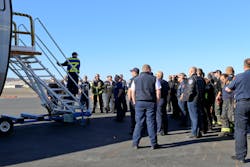A key component to strength and resiliency of operations at an airport is a cooperative and functional relationship with the surrounding communities. Being a good neighbor includes engagement of discussion about airport noise, land use and mutual aid resources that might be requested during an emergency. The Federal Aviation Administration (FAA) under guidance for airport emergency plans defines “mutual aid” as “reciprocal assistance by emergency services under a predetermined plan”. Strong mutual aid relationships with first responders including fire, police and medical are wise investments at an airport. An incident or emergency at an airport has the potential to quickly overwhelm emergency response resources allocated to that facility. When this happens, airports must rely on neighboring jurisdictions for resource requests in order to address life safety and ensure continuity of operations.
Similar to any strong and resilient relationship, each partner in a mutual aid relationship must contribute and benefit mutually from the arrangement. Because the FAA outlines specific regulations for aircraft rescue firefighters including response time, specialized equipment and training, airports are often unable to routinely send fire resources off-airport to assist neighboring jurisdictions without negatively affecting aircraft operations. Airports that regularly request mutual aid fire resources may not be routinely able to return the favor, therefore careful consideration must be given to how the “mutual” portion of mutual aid can be carried out effectively.
In order for mutual aid relationship to be successful, airports must think outside of the box to engage partners. What are your mutual aid partners’ needs and common goals? Do you have specialty equipment or resources that may be shared? Can airports organize drills that dually address the training requirements of their mutual aid partners? Does your airport have facilities that may be offered up for training to your mutual aid partners? Common issues that arise with mutual aid relationships may include liability, politics, jurisdictional disagreements, funding and command/control issues. These questions and issues must be cooperatively analyzed, answered and communicated as a groundwork to functional mutual aid plans as local cooperation between resources is extremely powerful to address continuity of operations in the face of an emergency.
Fire departments, both on and off an airfield dedicate extensive time and resources to training and compliance. There is certainly wisdom in jurisdictions collaborating for purposes of training to offset the costs of developing and coordinating emergency response. Local governments are nearly consistently constrained by resources. Costs associated with developing and providing training may be shared amongst response agencies with the added benefit of having a common response plan and operating picture. A similar approach may be taken to share technology, equipment or training space, thus avoiding duplication where possible. Additionally, sharing resources allows for free exchange of information and experiences between entities to serve the individual and collaborative interests of each organization.
Airports are inherently ideal operating environments for fire departments to conduct trainings. By routinely inviting outside agencies inside the airfield fence for training, they become exposed to and familiar with the aspects of response that are unique to an airfield. Mutual aid agencies thus become more familiar with airfield access considerations, driving requirements, hazardous materials and coordination requirements with airport stakeholders. By conducting drills and exercises on an airfield, mutual aid agencies become a part of the airport community with a clearer understanding of what might be needed from them in an emergency. This allows agencies to have a better grasp of what makes an airfield operating environment unique and how response differs from scenarios such as a vehicle collision or a residential structure fire that they may be routinely responding to.
Regular hands-on training and exercise are vital to a strong mutual aid relationships. Most airports, by way of FAA regulation are required to meet with their partners annually to review emergency response procedures for an aircraft accident. Inclusion of functional drills in an ongoing exercise plan including those that mutual aid resources do not need necessarily need to be taken out of service to participate in, or drills that allow partners to meet their internal requirement for training effectively promote collaboration. Financial and personnel resources are often scare for responders to plan and conduct large exercises. By pooling resources, agencies may plan and conduct training exercises that meet more than a single agenda without heavy resource taxation on any single agency.
Consideration should also be given to routinely meeting with mutual aid partners outside of emergency response or training scenarios. Airports, at a minimum are a dynamic and exciting operating environment to visit. Airports may be able to provide meeting space or facilities for training to support mutual aid relations. Relationship building by hosting open houses, airfield tours, communication with tenants, airline partners and introductions to air traffic control tower operations provides an education that directly correlates with successful emergency response in an airfield environment. Local fire departments may benefit from the opportunity to become familiar with the type of aircraft that operate out of their neighboring airfield. Aircraft rescue and firefighting units may choose to invite mutual aid partners to annual live burn training or basic aircraft rescue and firefighting training courses.
Establishing personal relationships fosters communication and team-building that far exceeds a basic working response relationship. As we often hear in emergency management, the wrong time to exchange business cards is at an emergency scene. In an actual emergency, geographical borders of an airport fence no longer effectively exist. Active engagement and relationship building in advance of an emergency allows for the focus to shift from differences, or simply what one agency needs to how multiple agencies can work together to save lives and property in their jurisdiction. Adequate training, equipment and positive community relationships promote growth and economic opportunity in a municipality.
Airports are compelled to identify the capabilities and needs of mutual aid partners for effective engagement. Careful consideration of local resources to pool and share and how training opportunities may create competency and efficiency is essential to resilient partnerships. Establishing relationships with neighbors and engaging in discussion of resources is vital to an airport community before, during and after an emergency. Airports must routinely think outside of the box to promote engagement and a symbiotic relationship with response partners to build airport and community resiliency.
Charity Catalfomo is the Safety and Security Manager at one of the nation’s busiest primary non-hub airports . Charity is responsible for emergency planning and works closely with fire, law enforcement, airport operations ,local and federal agencies. Her background includes airfield operations and maintenance at a large hub airport and a Master’s degree in Emergency Management.
About the Author

